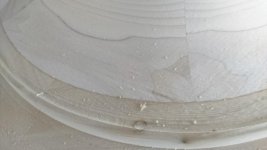Pattnmaker
Stainless
- Joined
- Nov 2, 2007
- Location
- Hamilton, Ontario
I have a new router with a Fagor 8037 controller. I had some problems early on with the machine doing some weird moves violating the work. It machined right through the center of a boss. (all 3d work) If I ran through single block it did not violate the job. However anything past 10% feed override it gave a counterclockwise rapid instead of a clockwise cut in this area.
I spoke with Tech support at my supplier and he questioned why my program was outputting G2s and G3s. I told him I used smoothing in my Cam software (HSMWorks) to minimize program size and that my other router ran much more smoothly and avoided jerky movements using smoothing. He told me to set the software to just use G01s. This solved the crashing issue and works reasonably well with geometry that has straight sections in it to allow the controller to catch up. However cutting round parts or larger parts with complex geometry the machine is jerky even at 60% feed and I get a terrible finish. I took a risk and ran smoothing on a semi finishing toolpath tool today and I got a better finish than my finishing toolpath. The finish is all dimpled like a golf ball but way more dimples. I am almost positive I am getting Data starving.
Is this a common issue with this controller? All my jobs are 3D machining and I need to be able to run this machine at a decent feedrate with a good finish. I would prefer to use smoothing as the files are considerably larger and they are taking forever to load on the machine. As well it is something I have to make sure I change in my settings in HSMWorks. I am working up a new set of templates with smoothing turned off.
Is there a parameter that can be changed on the controller to allow it to take the smoothing toolpaths? Or another solution? I will be contacting the router manufacturer next week about the finish as I am sure there are parameter changes that will help but I would love to have a little more information before talking to them.
I spoke with Tech support at my supplier and he questioned why my program was outputting G2s and G3s. I told him I used smoothing in my Cam software (HSMWorks) to minimize program size and that my other router ran much more smoothly and avoided jerky movements using smoothing. He told me to set the software to just use G01s. This solved the crashing issue and works reasonably well with geometry that has straight sections in it to allow the controller to catch up. However cutting round parts or larger parts with complex geometry the machine is jerky even at 60% feed and I get a terrible finish. I took a risk and ran smoothing on a semi finishing toolpath tool today and I got a better finish than my finishing toolpath. The finish is all dimpled like a golf ball but way more dimples. I am almost positive I am getting Data starving.
Is this a common issue with this controller? All my jobs are 3D machining and I need to be able to run this machine at a decent feedrate with a good finish. I would prefer to use smoothing as the files are considerably larger and they are taking forever to load on the machine. As well it is something I have to make sure I change in my settings in HSMWorks. I am working up a new set of templates with smoothing turned off.
Is there a parameter that can be changed on the controller to allow it to take the smoothing toolpaths? Or another solution? I will be contacting the router manufacturer next week about the finish as I am sure there are parameter changes that will help but I would love to have a little more information before talking to them.




